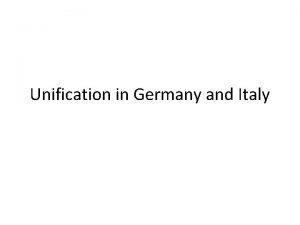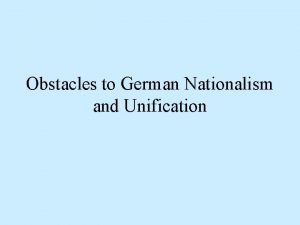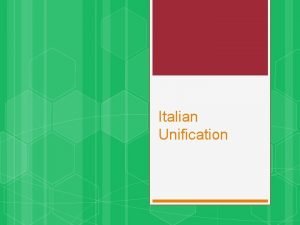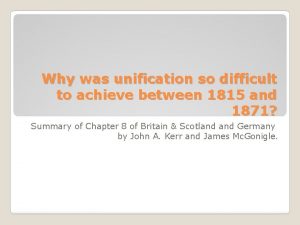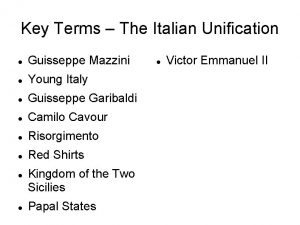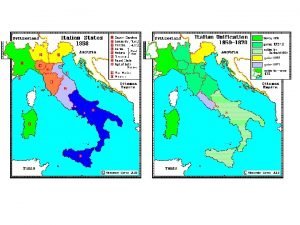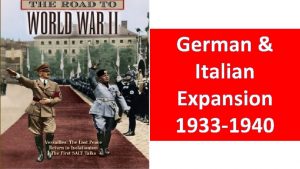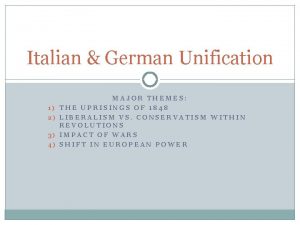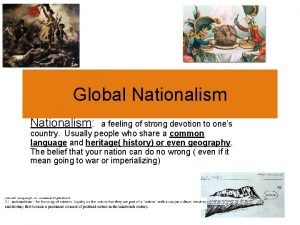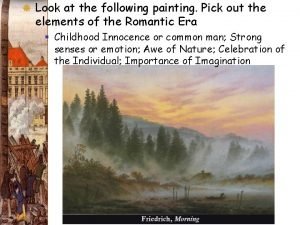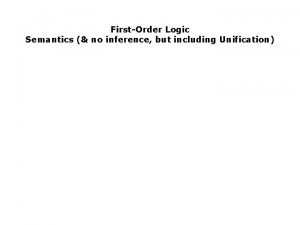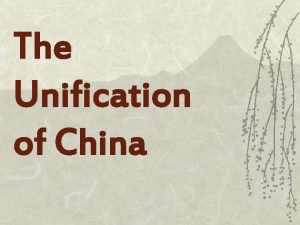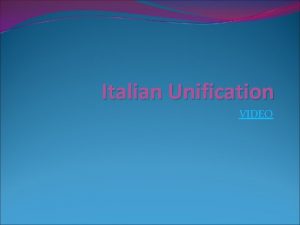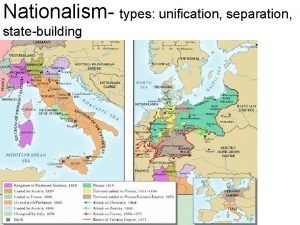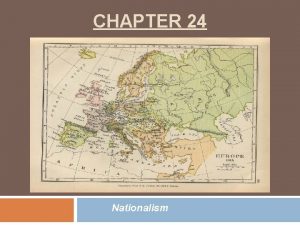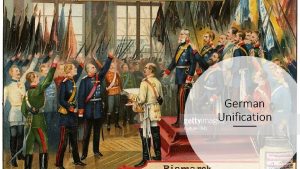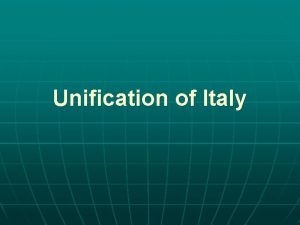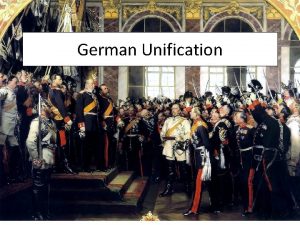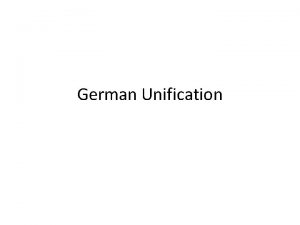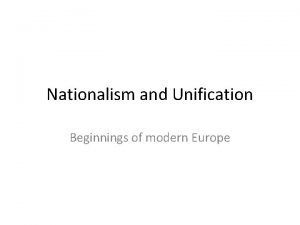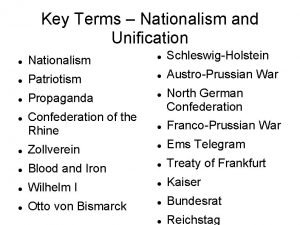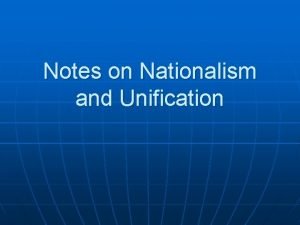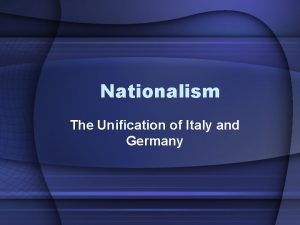Unification A story of German and Italian Nationalism




















- Slides: 20

Unification A story of German and Italian Nationalism

Nationalism • Nationalism- Is the belief that one’s greatest loyalty should not be to a king or an empire but to a nation of people who share a common culture and history. • Often paired with the desire for this groups own independent government, becoming a nationstate.

Bonds that Create a Nation State (1800’s Context) Nationality: A belief in a common ethnic ancestry. Language: Different dialects (forms) of one language; one dialect chosen as the “national language”. History: A common past, common experiences. Religion: A religion shared by all or most of the people. Territory: A certain territory that belongs to the ethnic group; its “land”.

Types of Nationalist Movements Types Characteristics Examples Unification Mergers of politically divided but culturally similar lands. 19 th Century Germany and Italy Separation Culturally distinct group resists being added to a state or tries to break away French speaking Canadians. State-Building Culturally distinct groups form into a new state by accepting a single culture The United States

Nationalism a Force of Disunity • In the 1800’s a growing sense of nationalism challenges three old empires: • 1. Russia • 2. Austrian Empire • 3. Ottoman Empire • All three of these would eventually collapse.

After Napoleon • Italy and Germany had been devastated by Napoleon, and wanted to avoid French domination • German Confederation: Formed in 1815 at the Congress of Vienna, replacing the Holy Roman Empire. • Result- A loose confederation/ political association of 39 states. • The two largest states dominate the confederation: • 1. Prussia. • 2. Austro-Hungarian Empire/ Austrian Empire.

Barriers to German Unification • France preferred 39 weak states to a single unified nation. • Austria knew Prussia was most powerful state. • Rulers of smaller states feared loss of power in a united Germany. • Protestant/ Catholic divide. (From the 30 years war) • Economic Differences between western industrial states and agricultural eastern and southern states.

Barriers to Italian Unification • France, Austria and the Pope all wanted to maintain their balance of power in Italy • Each region of Italy was very culturally and linguistically distinct. • Economic Differences between wealthy northern industrial cities and agricultural poor south • Risorgimento: “Rising again”, Italian nationalism was based on the Roman empire, and thus viewed as a radical threat.

Prussia: Leaders of German Unification King Wilhelm I Very Authoritarian, had a very strong hold over both: • 1. Military • 2. Government - Had been offered to be constitutional monarch of Germany in 1848, but refused. Then! He attempts to enlarge the Prussian military but meets opposition from the Prussian Parliament (Junkers). Result! Appoints new Prime Minister, Otto von Bismarck to get what he wants.

Otto von Bismarck • Becomes Prime Minister in 1862. (Conservative Junker) • Continues to expand the military rapidly. • Realpolitik- (the politics of reality): politics that leaves no room for idealism, based on practical matters rather than theories or ethics. • So! He is opposed to liberalism and socialism, instead he embraces tough power politics with no idealism.

Bismarck's Policy of “Blut und Eisen” • “ Not by speeches and resolutions of majorities are the great questions of the times decided upon – but by blood and iron”

Sardinia. Piedmont: Leaders of Italian Unification King Victor Emmanuel II Was very concerned with controlling liberal and left-wing Italian nationalists - Wanted a strong, Conservative Italy - Feared that if he didn’t unite them, his own people would form a republic Had been trying to pry the Austrians out of northern Italy for years but was less concerned with the south. Result: Hired a legendary mercenary to lead expeditions to southern Italy, Giuseppe Garibaldi

Giuseppe Garibaldi • Not an official general for SP – lead a band of adventurers named the Expedition of the thousand • Had spent years as a mercenary and cowboy fighting all over the Americas and Europe • Young Italy: Founded before 1848, a radical group of students focused on nationalism and democracy • Carbonari - (the charcoal makers): a secret conspiracy society that advocated for Italian unification through any means.

Steps to German Unification • 1864 -1866 (Alliance between Prussia and Austria) • War against Denmark to win two border provinces: Schleswig and Holstein. • Result! A quick victory. Prussia governed Schleswig and Austria, Holstein.

Seven Weeks War • 1866 -1867 Seven Weeks War • Bismarck (Prussia) purposely stirred up border conflicts with Austria over Schleswig and Holstein. • Result! Austria declares war on Prussia in 1866. • Prussia humiliates Austria and takes its Northern states joining the North German Confederation. • Sardinia-Piedmont takes Austrian territory in Venetia to support Prussia • Sardinia-Piedmont also fully incorporates Naples and Tuscany – two Austrian allies.

1870 -1871: The Franco. Prussian War • Bismarck realizes that the French would never be content with a strong German state to its east. (security threat) • So! - Prussia declares war on France, July 19, 1870 and invade France. • Result- On September 2 nd 1870, Prussia defeats the French forces aided by southern German states. • French troops had been protecting the Pope in Rome – with them gone to fight Prussia, they walked in take it! • Gains- The Prussians gain the French territories of Alsace and Lorraine. The Italians gain their new capital, Rome

German Unification • Even before the end of the war the Southern German states agreed to enter the Northern German Confederation. • Wilhelm I is crowned Kaiser (Emperor) at the palace of Versailles. • Result! This unites all the German territories into the Second German empire.


The Balance of Power Shifts • We now have five great European Powers: • 1. Britain • 2. France • 3. Austria • 4. Russia • 5. Germany- Considered to be the most powerful of these 5 powers. • + Italy – Not quite a great power – but wants in on the prestige and glory

Assignment – Idealism or Pragmatism? • The process of national unification often saw a clash between those who acted on their ideals and those who acted pragmatically. • Using Bismarck and Garibaldi as an inspiration, write a 1 -page response on a political figure of your choosing – arguing whether they have succeeded due to pragmatism or sticking to their ideals! • Cite at least 1 source (Chicago style and reputable), and use our 3 -step arguing process: 1. Evidence 2. Explain 3. Relate
 German and italian unification compare and contrast
German and italian unification compare and contrast Chapter 23 lesson 3 nationalism unification and reform
Chapter 23 lesson 3 nationalism unification and reform Sardina
Sardina Obstacles to german unification
Obstacles to german unification Stages of german unification
Stages of german unification Summary of italian unification
Summary of italian unification Why was italian unification difficult to achieve
Why was italian unification difficult to achieve Obstacles to italian unification
Obstacles to italian unification Heart of italian unification
Heart of italian unification German and italian expansion
German and italian expansion Low german vs high german
Low german vs high german National unification and the national state
National unification and the national state Prolog langage
Prolog langage Love my country
Love my country Germany before unification
Germany before unification St an
St an Unification operating model
Unification operating model First order logic unification
First order logic unification Why did germany avoid “wounding austria too severely”?
Why did germany avoid “wounding austria too severely”? Unification of china
Unification of china Prolog unification
Prolog unification
